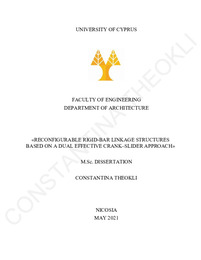| dc.contributor.advisor | Phocas, Marios C. | en |
| dc.contributor.author | Theokli, Constantina Y. | en |
| dc.coverage.spatial | Cyprus | en |
| dc.creator | Theokli, Constantina Y. | en |
| dc.date.accessioned | 2022-02-16T09:51:44Z | |
| dc.date.available | 2022-02-16T09:51:44Z | |
| dc.date.issued | 2021-05-10 | |
| dc.identifier.uri | http://gnosis.library.ucy.ac.cy/handle/7/65037 | en |
| dc.description.abstract | Deployable structures have been used throughout history, but it was not until the beginning of the twentieth Century that there was an emergency of thought inspired by the speed and technological advances of the Industrial Revolution. This type of structures can be considered a special case within the broader class of adaptive and morphing structures, which are characterized by their ability to change shape. In this context, adaptability, as a post-design reflection progress, refers to a framework within which variable and fixed parameters are defined in such a way that customization and optimization are enhanced at various levels.
The current research focuses on the design and analysis of a reconfigurable structure and the investigation of its morphological and kinetic behavior. It refers to the Effective Crank–Slider reconfiguration approach, namely a kinematics approach that stepwise reduces a planar system to an externally actuated 1-DOF system, in order to adjust each joint angle of the planar system from an initial to a target position. Two control system configurations are proposed following horizontal and vertical actuation of the structure. The structure consists of aluminum bars, interconnected via joints and sliders. At midspan the structural linkage is further supported on diagonals positioned within the system to form a V- or X-shape according to the reconfiguration requirements of the system. In the first alternative, the V-diagonals are rigidly supported on the structural grid at midspan and pin connected with a horizontal member on the top. On the top of the structure there is a linear actuator and a sliding block that allows movement of the structure. In the second alternative, the X-diagonals are pin supported on the structural grid and connected with the beam of the linkage at midspan. The diagonals consist of four telescopic round hollow sections with an actuator attached to each one, that control the kinematics of the linkage. Each internal joint of the linkage is equipped with brakes, whereas in each reconfiguration step, two joints are released. Through movement of the slider in each step, the selected joint angles adjustment may provide symmetrical or non-symmetrical configurations of the system.
Initially, the typologies of deployable and reconfigurable lightweight structures are presented. The analysis of the proposed systems is based on the initial and target position of the corresponding planar linkages. In following, aspects of construction design of the spatial structure are presented, referring to the system supports, the members and their joint connections, as well as the actuation components that enable horizontal or vertical reconfigurations. Subsequently, related control concepts and motion planning alternatives are investigated. Among different feasible sequences, the ones with less required steps are selected and investigated with regard to the highest maximum brake torques and slider displacements. The corresponding spatial structure envelope consists of ETFE membranes with integrated thin photovoltaic films on two longitudinal rows on each side. In a simulation analysis are derived the solar irradiance and the energy production by the Photovoltaic units in all reconfiguration steps of the system from the initial to the target position. The case study refers to Larnaca, Cyprus, and the solstices occur annually, on the 21st of December, March, June and September.
The overall aim of the study is the development and investigation of a reconfigurable system, achieving specific symmetrical and non-symmetrical configurations with as few reconfiguration steps as possible. The kinematics approach applied provides maximum flexibility and endurance with minimum required actuation energy. The photovoltaic units integrated with the flexible building envelope enable high levels of energy production, exceeding the respective performance of a correesponding fixed shape building. | en |
| dc.language.iso | eng | en |
| dc.publisher | Πανεπιστήμιο Κύπρου, Πολυτεχνική Σχολή / University of Cyprus, Faculty of Engineering | |
| dc.rights | info:eu-repo/semantics/openAccess | en |
| dc.rights | Open Access | en |
| dc.title | Reconfigurable Rigid-Bar Linkage Structures Based on a Dual Effective Crank – Slider Approach | en |
| dc.type | info:eu-repo/semantics/masterThesis | en |
| dc.contributor.committeemember | Phocas, Marios C. | en |
| dc.contributor.committeemember | Michael, Aimilios | en |
| dc.contributor.committeemember | Christoforou, Eftychios | en |
| dc.contributor.department | Τμήμα Αρχιτεκτονικής / Department of Architecture | |
| dc.subject.uncontrolledterm | ARCHITECTURE | en |
| dc.subject.uncontrolledterm | DEPLOYABLE STRUCTURES | en |
| dc.subject.uncontrolledterm | RECONFIGURABLE | en |
| dc.subject.uncontrolledterm | 1-DOF | en |
| dc.subject.uncontrolledterm | BAR LINKAGE | en |
| dc.author.faculty | Πολυτεχνική Σχολή / Faculty of Engineering | |
| dc.author.department | Τμήμα Αρχιτεκτονικής / Department of Architecture | |
| dc.type.uhtype | Master Thesis | en |
| dc.contributor.orcid | Phocas, Marios C. [0000-0003-1785-7978] | |
| dc.gnosis.orcid | 0000-0003-1785-7978 | |

